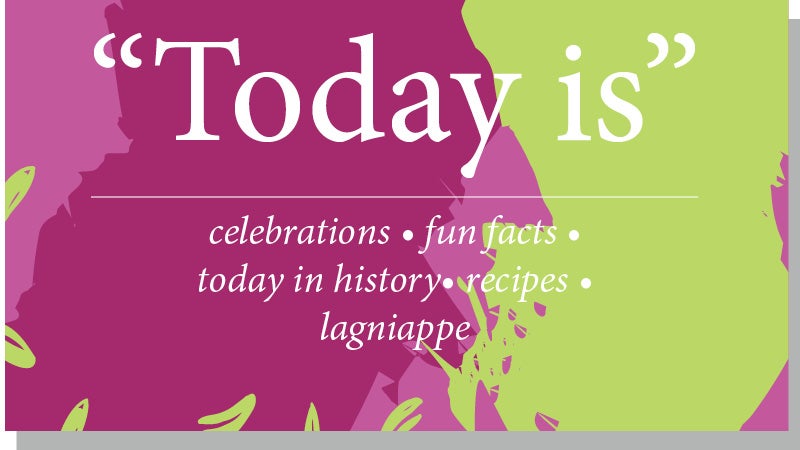Today is March 13
Published 8:00 am Saturday, March 13, 2021
|
Getting your Trinity Audio player ready...
|
In 1884 the U.S. Adopted Standard Time
Don’t forget to push your clocks forward one hour this evening.
**
National Genealogy Day
Tips for Handling Family Papers and Photographs
Have a clean, clear space prepared to place the originals before you get them out.
Don’t eat, drink, or smoke around originals.
Wash hands before handling paper and don’t apply lotion as it can stain paper. Paper can be handled without gloves because clean, lotion-free hands will not stain the paper and gloves can make it hard to handle delicate paper.
Handle photographs and negatives with gloves. Fingerprints can cause permanent stains on photographs and negatives.
For more information visit https://www.archives.gov/research/genealogy.
**
National Jewel Day
Diamonds are the stone of choice for engagement rings and wedding jewelry. Diamonds are durable and remain a timeless way to complement every style.
Anyone who is about to purchase a diamond is encouraged to do their research about selecting quality diamonds. At the heart of the diamond grading process are the 4 Cs of diamond quality. The Cs refer to carat weight, color grade, clarity grade, and cut grade. The Gemological Institute of America helped to create the Diamond 4 Cs and the International Diamond Grading System®. These benchmarks are used to classify all diamonds.
The following is the GIA’s explanation of each component of the system.
- Carat: Diamond carat weight is the measurement of how much the diamond weighs and is equivalent to 200 milligrams per carat. Each carat is subdivided into 100 points. Therefore, a one-carat diamond is 1.00 or 100 points, while a twenty-five point diamond is .25 carats. Naturally, larger diamonds can be more rare and desirable.
- Color: A white diamond is more valuable the less color it contains. GIA uses a D-to-Z grading system to determine a diamond’s color value. D would be a colorless diamond and Z the most saturated with color.
- Clarity: Diamonds are formed by carbon exposed to heat and pressure. Natural internal characteristics known as inclusions and external components called blemishes are the norm. The closer the gem comes to being perfectly pure without inclusions or blemishes, the greater the value.
- Cut: To transmit light and sparkle, diamonds have to be cut precisely and with great artistry. A diamond will be further graded based on symmetry and proportions, as well as how the stone returns light. Brightness, which is the internal and external white light reflected; fire, or the scattering of white light into rainbow colors; and scintillation, or the sparkle the diamond produces, are factored into how the cut is valued.
Diamonds are a major investment. Consumers who do their research and verify diamond grading can get the best value for their money.
**
In 1964 American Kitty Genovese is murdered, reportedly in view of neighbors who did nothing to help her. This event inspired the creation of Good Samaritan Involvement Day celebrated today.
**
Coconut Torte Day
Betty Crocker Blue Coconut Torte
Ingredients
1 box Betty Crocker™ Super Moist™ white cake mix
1 cup water
1/3 cup oil
¼ cup buttermilk
3 egg whites
2 oz white chocolate, melted
Liquid blue food color
2 ½ containers (12 oz each) Betty Crocker™ Whipped fluffy white frosting
2 cups sweetened flaked coconut
Silver buttons and/or dragées
White chocolate snowflakes in assorted sizes
Steps
Heat oven to 350°F (325°F for dark or nonstick pans). Grease 2 (9-inch) round cake pans with shortening; lightly flour.
In large bowl, beat cake mix, water, oil, buttermilk and egg whites with electric mixer on medium speed. Beat in melted white chocolate. Add about 20 drops blue food color to batter; mix well. Scrape down bowl; mix again until no white streaks remain. Pour batter into pans. Bake as directed on cake mix box for 2 (9-inch) rounds. Cool cakes completely before frosting.
Level each cake using large serrated knife or cake leveler. Cut each cake in half horizontally so there are four cake layers total. Reserve 1/2 cup frosting for later use; use remaining frosting to fill and frost entire cake.
Press coconut onto top and sides of cake. Transfer reserved 1/2 cup frosting to decorating bag fitted with large star tip. Pipe rosettes around top edge of cake. Top each rosette with silver button. Press candy snowflakes standing upright into top of cake. Store cake loosely covered.
For more recipes visit https://www.bettycrocker.com/recipes
***






